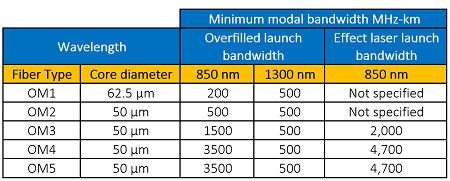OM TYPES
OM4 and OM5 multimode fibers demonstrate identical bandwidth and performance figures at the commonly used 850 nm wavelength for traditional Gigabit Ethernet and 10 Gigabit Ethernet applications. However, the key differentiator of OM5 lies in its versatility, as it can support additional wavelengths beyond 850 nm, specifically in the range of 880 nm to 960 nm. This extended wavelength range not only enables the utilization of Wavelength Division Multiplexing (WDM) technology but also underscores the adaptability of OM5 fiber to a wide range of applications, instilling confidence in its versatility.
Typically, OM5 fiber supports up to 4 distinct wavelengths within the specified range, enabling higher aggregate bandwidth than OM4 fiber. Moreover, OM5 fiber offers higher bandwidth and longer reach at these higher wavelengths (880-960 nm) compared to OM4 fiber. This makes OM5 fiber more suitable for future high-speed applications and longer distances in data center and enterprise environments, where the demand for increased bandwidth and capacity continues to grow.
While the bandwidth and performance figures for OM4 and OM5 are identical at 850 nm, OM5’s support for additional wavelengths and WDM technology unlock the potential for higher aggregate bandwidth and increased capacity over the same fiber infrastructure.

The typical fiber-based Ethernet applications, supported distances for each OM, and related loss limits are shown in the table below. For an application to function, distance and loss must be considered.

CISCO OM3/OM4 40/100/200/400G

The list of the top-selling 100 Gb/s transceivers is shown in the chart below:

The high-volume 200 and 400 Gb/s transceivers are listed below:

Source: Cisco 100GBASE-SQGP 100G Modules Data Sheet, May 2018
FIBER OM4 vs OM5
40/100GbE Max Distances:
| Standard | OM3 | OM4 | OM5 |
|---|---|---|---|
| 40G SWDM | 240 m | 350 m | 440 m |
| 100G SWDM | 75 m | 100 m | 150 m |
| Fiber Type | OM4 | OM5 |
|---|---|---|
| 10GbE | 400 m | 400 m |
| 40GbE | 150 m | 150 m |
| 100GbE | 150 m | 150 m |
| 40G-SWDM4 | 400 m | 500 m |
| 100G-SWDM4 | 100 m | 150 m |